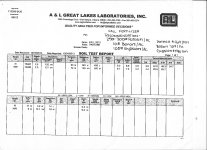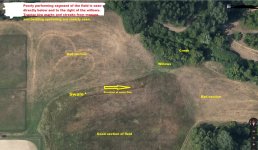tmac196
Silver Member
- Joined
- Aug 10, 2010
- Messages
- 163
- Location
- Temperance, MI
- Tractor
- 1951 Ford 8N, 1965 Ford 2000, Grasshopper 325D, JD 5065M
I am at a crossroads and in need of advice. I raise hay for our horses on my own property. This is our third hay season. One segment of my hay field, which encompasses about 40% of the entire field, is very under-productive. The grasses present are sparse, slow growing and the yield is next to nothing. Small clumps of grass are surrounded by patches of bare ground and in one low segment an invasive species of willow with it's expansive root system is beginning to creep farther and farther into the field choking out the grass and what little clover and alfalfa are present.
This segment of the field borders a creek whose banks are elevated slightly higher than the field due to the spoils left behind by county ditch commission contractors who have "cleaned" the ditch in years past and is separated from the rest of the hay field by a shallow swale which currently drains all of the run off from our barn, sheds and indoor riding arena roofs to the creek. The terminus of the swale at the creek is generally more moist and this is where I have the willow problem.
Our soil is pure yellow sand which percolates particularly well. The poorly performing segment of the field which I am in need of help with was used by the previous owner of the property as a location to spread the mixture of raw horse manure and pine shavings which the horses were bedded on for some time. I am told that the pine shavings are very acidifying and rob the soil of nitrogen as they decompose.
I checked with my local extension agent and my Co-op and received the same advice: Test the soil and, if need be, amend it, so I did. Here are the results from last fall. The segment of the field in question is labelled as "N" in this soil test.

Last fall, I subsequently applied the amendments recommended by the Co-op on the analysis sheet and waited. This spring we etched the surface of the field with a disc and "frost seeded" red clover. This was successful in establishing clover in the most productive areas of my field, but was an utter failure in the segment in question. I have fertilized this area twice (fall 2012 and spring 2013) with a granular combo fertilizer mixture provided by the Co-op and it has received lime once (fall 2012).
Disappointingly, the yield this year is no better.
So now what do I do? I have considered hitting the segment with Round Up, plowing it under and reseeding, adding more lime (pH was 6.2 on the soil test analysis), attempting to renovate the field with a ripper and more fertilizer after the pH is more neutral, discing it up now vs. next spring and reseeding, etc.
Any learned advice will be appreciated.
This segment of the field borders a creek whose banks are elevated slightly higher than the field due to the spoils left behind by county ditch commission contractors who have "cleaned" the ditch in years past and is separated from the rest of the hay field by a shallow swale which currently drains all of the run off from our barn, sheds and indoor riding arena roofs to the creek. The terminus of the swale at the creek is generally more moist and this is where I have the willow problem.
Our soil is pure yellow sand which percolates particularly well. The poorly performing segment of the field which I am in need of help with was used by the previous owner of the property as a location to spread the mixture of raw horse manure and pine shavings which the horses were bedded on for some time. I am told that the pine shavings are very acidifying and rob the soil of nitrogen as they decompose.
I checked with my local extension agent and my Co-op and received the same advice: Test the soil and, if need be, amend it, so I did. Here are the results from last fall. The segment of the field in question is labelled as "N" in this soil test.

Last fall, I subsequently applied the amendments recommended by the Co-op on the analysis sheet and waited. This spring we etched the surface of the field with a disc and "frost seeded" red clover. This was successful in establishing clover in the most productive areas of my field, but was an utter failure in the segment in question. I have fertilized this area twice (fall 2012 and spring 2013) with a granular combo fertilizer mixture provided by the Co-op and it has received lime once (fall 2012).
Disappointingly, the yield this year is no better.
So now what do I do? I have considered hitting the segment with Round Up, plowing it under and reseeding, adding more lime (pH was 6.2 on the soil test analysis), attempting to renovate the field with a ripper and more fertilizer after the pH is more neutral, discing it up now vs. next spring and reseeding, etc.
Any learned advice will be appreciated.
